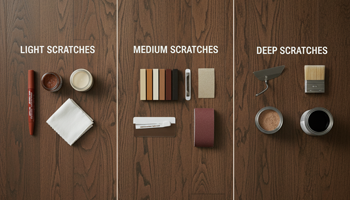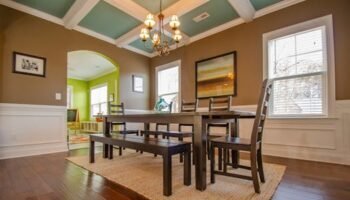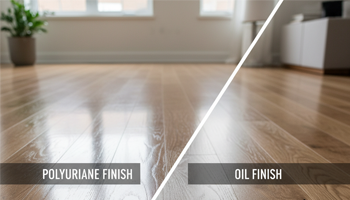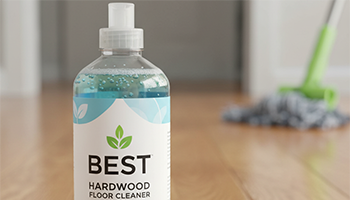Humidity Control for Hardwood Stairs & Trim: Prevent Gaps, Squeaks & Separation
If you’re wondering what humidity level protects hardwood stair treads and trim, here’s the short answer: keep indoor relative humidity (RH) between 35–55% year-round, with 40–45% RH in winter and 45–55% RH in summer, at 60–80°F. After 20+ years in flooring, I can tell you most gaps, squeaks, cupping treads, and trim separation are humidity problems—not product defects—and 95% are preventable with a $20–$100 hygrometer and the right humidifier/dehumidifier strategy.
Action key: Log RH in every level (especially landings and basements), correct fast if RH dips <30% (emergency dry) or spikes >65% (high cupping/separation risk).
Why Humidity Matters for Stairs & Trim
Hygroscopic wood 101
Stair parts (treads, risers, nosings, stringers, skirt boards) and architectural trim (baseboards, casing, crown, shoe molding) are hygroscopic: they absorb/release moisture as ambient RH changes. That means swelling in humid months and shrinkage in dry, heated months.
Where movement shows up
- Stair treads/risers: hairline winter gaps between tread and riser, or between tread and skirt board; summer edge lift/cupping on wide treads.
- Trim: open miter joints, baseboard-to-floor gaps, crown molding drops from ceiling lines, or paint cracking along caulk lines.
Target zone for stairs & trim
Keep 35–55% RH (I aim 40–45% winter, 45–55% summer). That range aligns with guidance from groups like the National Wood Flooring Association and indoor-environment standards from ASHRAE.
Seasonal Patterns & Climate Factors
Winter (low RH → shrinkage)
Forced-air heat dries interiors. Expect hairline gaps, squeaks (friction at fasteners), and open trim miters. Minor movement that closes by spring is seasonal; persistent gaps need intervention.
Summer (high RH → swelling)
High RH swells wood. Watch for stair tread cupping, sticky trim joints, and paint/caulk cracks. If elevated RH persists for >2 months, wood can “set” in the deformed shape—repairs escalate.
Climate specifics
- Coastal/high-humidity: prioritize dehumidification and sealed crawlspaces.
- Inland/continental: plan aggressive winter humidification.
- Desert/very dry: maintain output to actually hit ≥40% RH indoors.
Normal vs. Problematic Movement (How to Tell)
- Normal seasonal: uniform hairline to dime-thickness gaps at tread/trim joints that close by late spring.
- Problem signs:
- Gaps remain after humidity normalizes.
- Isolated wide seams, stair nosing lift, or stringer-to-wall separation.
- Squeaks that persist despite proper RH.
- Crown molding dropping from the ceiling line or baseboards pulling free.
Measure to verify:
- Digital hygrometers on each level (avoid direct sun/vents).
- Wood moisture meters for suspect treads/trim to compare affected vs. control areas.
For leaks or mold concerns, consult EPA moisture guidance (<a href=»https://www.epa.gov/mold» rel=»nofollow»>EPA</a>).
Ideal Humidity Levels & Monitoring Plan
- Winter target: 40–45% RH to minimize shrinkage and squeaks.
- Summer target: 45–55% RH; basements/crawlspaces ≤50% RH.
- Temperature: 60–80°F.
- Monitoring: place sensors on every floor, including stair landings and finished basements; set smart alerts through thermostats (Nest/Ecobee) or hubs. See HVAC humidity control guide for automation.
Winter Solutions: Add Humidity (Without Creating Messes)
- Whole-house humidifiers (HVAC-integrated): Best consistency, least day-to-day effort. Typical investment $300–$1,500 plus install.
- Portable humidifiers (room/landing): Work if maintained; place near returns for better distribution.
- Types:
- Evaporative (balanced output, minimal white dust)
- Ultrasonic (quiet; use distilled water to avoid mineral residue)
- Steam (high output; higher cost)
- Maintenance: weekly cleaning, scheduled filter/pad changes. Neglect causes biofilm/mineral dust that soils trim/paint.
- Radiant heat stairs: heat from below accelerates drying; without strong humidification, I’ve seen ¼″ trim gaps and noisy stairs. Plan for higher winter output and room-by-room sensors.
Summer Solutions: Remove Humidity (Where It Starts)
- Air conditioning: Properly sized systems dehumidify during longer cycles; avoid oversizing (short cycles = poor moisture removal).
- Dehumidifiers:
- Main floors: 30–50 pints/day depending on area.
- Basements/crawlspaces under stairs: go larger (50–70+ pints/day) and drain continuously.
- Crawlspace control: ground vapor barriers, sealed vents, and mechanical dehumidification keep subfloor RH down.
- Recovery timeline: Will trim gaps close when humidity returns? Often yes within 2–3 weeks. If not, reassess moisture, fasteners, and caulk strategy.
Preventing Squeaks, Gaps & Separation (Pro Checklist)
Stair treads & risers
- Fasteners: secure treads/risers into stringers with adhesive + fasteners rated for the species; re-fasten squeaks where RH is already in range.
- Expansion: allow microclearances at skirts and wall interfaces; don’t overfill with rigid fillers that crack seasonally.
- Wide treads: species with high tangential movement are more cupping-prone—monitor closely in summer.
Trim (baseboards, casing, crown)
- Caulk strategy: elastic, paintable caulks; avoid hard fillers for seasonal joints. Re-caulk after RH stabilizes, not at the driest/wettest extreme.
- Paint/finish: paint after the first seasonal cycle if possible; finish films are less likely to crack over stabilized joints.
Installation & Retrofit Best Practices
- Acclimation: real-world success needs 4–7 days with boxes opened on-site and HVAC at normal settings. Rushed “24-hour acclimation” invites cupping/gaps.
- Moisture testing: always test concrete/substrates and use appropriate vapor retarders/barriers where required.
- Expansion allowances: stair skirts and trim need room to move; pinning everything tight to walls invites separation.
- Adhesives/fasteners: use products rated for the environment (e.g., cool basements vs heated upper floors).
Special Cases
- Radiant heat: double down on winter humidification; expect more movement near heat sources.
- Vacation homes: set HVAC to 45–50% RH while away; use sensors with alerts and dehumidifiers draining to a pump.
- Historic homes: plaster-and-lath walls plus old crawlspaces magnify movement—prioritize subfloor and crawlspace humidity control.
When to Call a Pro & What Insurance Covers
Insurance generally covers sudden water events; gradual humidity is often excluded. Keep photos, RH logs, and meter readings.
Call a pro if you see persistent cupping, buckling, or repeated trim separation after RH is stabilized for a few weeks. A certified inspector (see NWFA) can log ambient RH, wood moisture, and substrate moisture.
Humidity management practices follow Hardwood Floor Care, while compatible cleaning products are listed in Best Hardwood Floor Cleaner.
FAQs
What humidity level protects hardwood stair treads and trim?
Keep 35–55% RH year-round; I aim 40–45% in winter and 45–55% in summer at 60–80°F.
How to prevent stair tread gaps during winter heating season?
Maintain 40–45% RH, balance supply/return airflow, and only re-fasten once RH is in range.
Will trim gaps close when humidity returns in spring?
Often yes within 2–3 weeks of stabilized RH. If not, assess fasteners, substrate moisture, and caulk.
Whole-house humidifier vs portable for protecting stairs & trim?
Whole-house wins for consistency; portables work if you actually maintain them.
Do baseboard gaps mean moisture in the crawlspace?
Sometimes. Check crawlspace RH and install vapor barriers/dehumidification to keep it ≤50%.
Stairs and trim telegraph humidity problems faster than flat floors: squeaks, open miters, nosing lift, and paint cracks. Keep RH tight, fix moisture at the source (especially basements and crawlspaces), and use HVAC tools to automate control. Do that, and your stair treads stay flat, trim lines stay tight, and repaints become optional—not routine.
Currently viewing
Humidity Control for Stairs & Trim

Repair Scratches in Hardwood Floors
How to Repair Scratches in Hardwood Floors: Complete Guide by Severity Level If you’re staring…
Refinishing Hardwood Floors
Sand & Refinish vs Screen & Recoat — Complete Comparison Guide If you’re weighing screen…
Polyurethane vs Oil Finish Floors
Durability & Maintenance Comparison If you’re comparing polyurethane vs oil finish for hardwood floors, you’re…
Best Hardwood Floor Cleaner
pH-Neutral & No-Residue Options TL;DR (buyer’s snapshot): For most homes, a pH-neutral hardwood floor cleaner…
Hardwood Floor Care Masterclass
Complete Guide by Wood Species & Finish If you want hardwood floor care by species…
Seasonal Humidity Control Calendar (Stairs & Trim)
| Months | Targets | Actions |
|---|---|---|
| Jan–Mar | 40–45% RH, 68–72°F | Run whole-house humidifier; clean filters weekly; check landings/basements; address squeaks after RH stabilizes. |
| Apr–Jun | 45–50% RH | Dial back humidification; service AC; prep dehumidifiers; verify crawlspace vapor barrier; baseline moisture readings on treads/trim. |
| Jul–Sep | 45–55% RH | Extend AC cycles; run dehumidifiers (continuous drain); monitor stair landings over basements; watch for early tread edge shadows. |
| Oct–Dec | 40–45% RH | Switch to humidification; set smart alerts; re-caulk/paint only after RH holds steady; schedule pre-winter HVAC check. |





